Tropical Cyclone | Temperate Cyclone | |
Origin | Thermal Origin | Dynamic Origin – Coriolis Force, Movement of air masses. |
Latitude | Confined to 100 – 300 N and S of equator. | Confined to 350 – 650 N and S of equator. More pronounced in Northern hemisphere due to greater temperature contrast. |
Frontal system | Absent | The very cyclone formation is due to frontogenesis.[Occluded Front] |
Formation | They form only on seas with temperature more than 26-270 C. They dissipate on reaching the land. | Can form both on land as well as seas |
Season | Seasonal: Late summers (Aug – Oct) | Irregular. But few in summers and more in winters. |
Size | Limited to small area.
Typical size: 100 – 500 kms in diameter.
Varies with the strength of the cyclone.
| They cover a larger area.
Typical size: 300 – 2000 kms in diameter. Varies from region to region.
|
Shape | Elliptical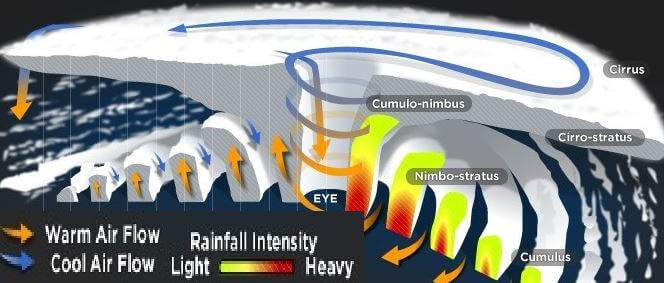 | Inverted ‘V’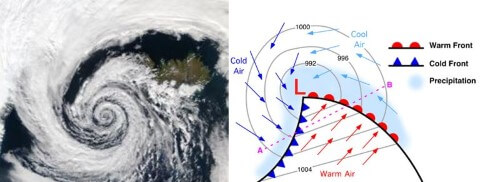 |
Rainfall | Heavy but does not last beyond a few hours. If the cyclone stays at a place, the rainfall may continue for many days. | In a temperate cyclone, rainfall is slow and continues for many days, sometimes even weeks. |
Wind Velocity and destruction | Much greater (100 – 250 kmph)(200 – 1200 kmph in upper troposphere)
Greater destruction due to winds, storm surges and torrential rains.
| Comparatively low. Typical range: 30 – 150 kmph.
Less destruction due to winds but more destruction due to flooding.
|
Isobars | Complete circles and the pressure gradient is steep | Isobars are usually ‘V’ shaped and the pressure gradient is low. |
Life time | Doesn’t last for more than a week | Last for 2-3 weeks. |
Path | East – West. Turn North at 200 latitude and west at 300 latitude.
Move away from equator.
The movement of Cyclones in Arabian Sea and Bay of Bengal is a little different.
Here, these storms are superimposed upon the monsoon circulation of the summer months, and they move in northerly direction along with the monsoon currents.
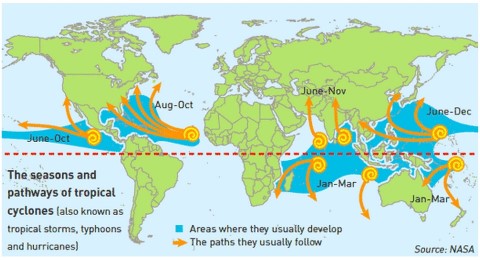 | West – East (Westerlies – Jet Streams). Move away from equator.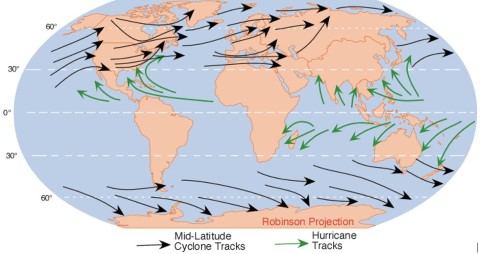 |
Temperature distribution | The temperature at the center is almost equally distributed. | All the sectors of the cyclone have different temperatures |
Calm region | The center of a tropical cyclone is known as the eye. The wind is calm at the center with no rainfall. | In a temperate cyclone, there is not a single place where winds and rains are inactive. |
Driving force | The tropical cyclone derives its energy from the latent heat of condensation, and the difference in densities of the air masses does not contribute to the energy of the cyclone. | The energy of a temperate cyclone depends on the densities of air masses. |
Influence of Jet streams | The relationship between tropical cyclones and the upper level air-flow is not very clear. | The temperate cyclones, in contrast, have a distinct relationship with upper level air flow (jet streams, Rossby waves etc.)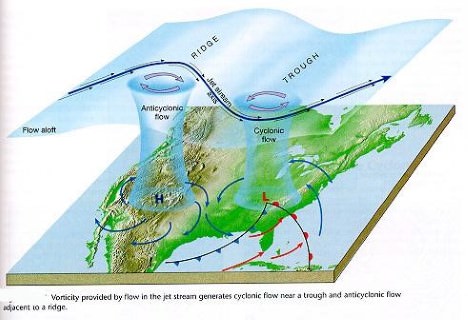 |
Clouds | The tropical cyclones exhibit fewer varieties of clouds – cumulonimbus, nimbostratus, etc.. | The temperate cyclones show a variety of cloud development at various elevations.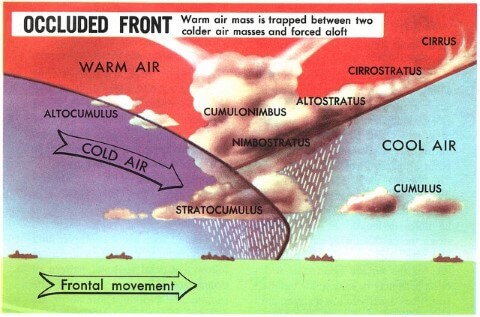 |
Surface anti-cyclones | The tropical cyclones are not associated with surface anticyclones and they have a greater destructive capacity. | The temperate cyclones are associated with anticyclones which precede and succeed a cyclone. These cyclones are not very destructive. |
Influence on India | Both coasts effected. But east coast is the hot spot. | Bring rains to North – West India. The associated instability is called ‘Western Disturbances’. |
- Titbit: In certain instances, two cyclones move toward each other and revolve around one another, with the smaller and less intense one moving more quickly. This phenomenon is called the Fujlwara effect.
References: NCERT Geography,

